In our journey toward eco-consciousness and a sustainable lifestyle, there’s a peril often concealed within our intentions: personal greenwashing. This topic can be a bit complex and weighty. We’ve put in the effort to simplify the concept. Feel free to reach out if you have any questions. We have also added a Glossary of Terms under Tips and Resouces so you can sluth out the meaning of complex lables and advertizing.
But in the meantime, let’s shed light on this subtle trap and discover how to navigate through it effectively. After all, knowledge is power and once we know about something we are doing that is inconsistent with our goals and intentions we can begin to make the changes to correct our path.
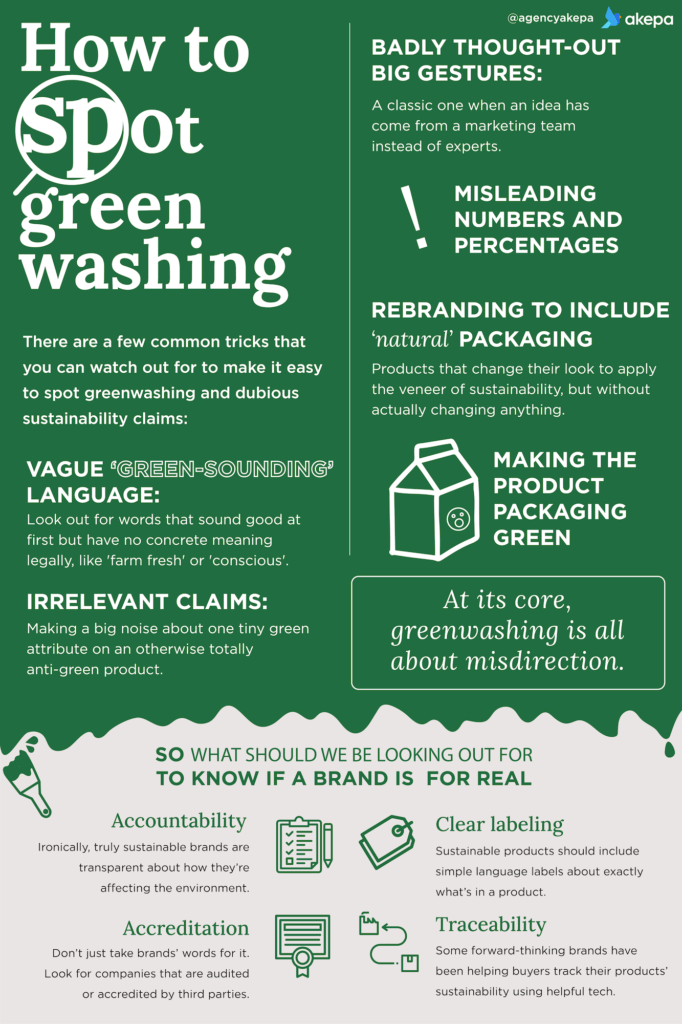
What is the Definition of Greenwashing
The term “greenwashing” is a blend of “green,” associated with environmentalism, and “whitewashing,” which means covering up or glossing over undesirable facts. Greenwashing can take various forms, and companies may employ a range of tactics to create a facade of environmental responsibility. These tactics often involve using eco-friendly buzzwords, symbols, or imagery without substantial evidence to support their claims.
Common examples of greenwashing include vague or unverifiable environmental claims, false certifications, highlighting a small eco-friendly aspect while ignoring broader environmentally harmful practices, and using misleading imagery to evoke nature or sustainability.
info graphic by: akepa digital marketing www.thesustainableagency.com
Understanding Personal Greenwashing
Personal greenwashing masks itself as environmentally conscious behavior, but it often contradicts sustainable principles. Let’s delve into what it entails and how it manifests in our personal lives.
Spotting the Signs
Beware of Tokenism: Symbolic gestures, like using reusable bags sporadically, may seem eco-friendly, but is this allowing us to overlook other significant sustainable habits?

Blind Spots in Purchasing: It’s important to investigate the complete environmental implications of purchases, including hidden aspects like excessive packaging or non-recyclable materials. Yes, it takes extra time to sleuth out the real products that maintain your sustainable lifestyle while providing you with the result you are seeking. You can start with these links these organizations are doing the heavy lifting of research for us. Earth.org, Natural Resources Defense Council, Green America, and the EPA.
Rationalizing Unconscious Habits: Often, we justify actions that might not align with eco-friendliness, such as opting for convenience over sustainability. This one is so easy to succumb to. I find myself in a position to do just that almost daily, especially on shopping days or out and about in a rush to complete errands.
Imagine this situation: suppose I forget to bring my coffee container and really want a latte. It’s super easy to think, “Just this once,” swing by a drive-thru coffee kiosk, and grab a latte in a paper cup with a plastic top, maybe even a straw – none of which can be recycled. Guilt might creep in, but let’s remember, mistakes happen. Before acting, let’s take a moment to think about our habits. Here are some other actions I could have taken to avoid this misstep and the guilt:
- Don’t buy the latte. I know this is a rough one, no one is perfect. When I really want a coffee after running hours worth of errands or having left the house without my “morning joe” I too will opt for a compromise.
- Keep multiple coffee containers in the car. Not many have the room or inclination to have many containers bouncing around thier car. BUT it is an option for some.
- Have my car supplies by the door in a cloth bag to grab and go. I have not done this yet, but need to implement it.
- Make a habit of washing and replacing my coffee container in the car. If I make my go bag for the car this becomes an easy option.
- Make the latte at home and bring it in my container. This is a very good option, but I must say sometimes I feel like it tastes better when others make it for me. I know, physcological, but I do like the local coffee kioske latter over mine.
- Find a a favorite coffee shop that serves in a ceramic mug and you can sit and enjoy the latte. If the reason you are going to the kioske is due to time constraints this also will be difficult.
So what to do with this little example of potential personal greenwashing? You can see that any of the above solutions will help but we must forgive ourselves when we fall short of our sustainable goals and begin again. We must allow ourselves the humanity to self correct when we see recognize the disparity between our goals and our actual behavior. The best approach is to commend ourselves for staying mindful and adjusting our behavior as we progress.
That example was a small bite, you might think about it this way. Consider another example of not-so-perfect eco-friendly choices. I occasionally purchase plastic items from Costco and Trader Joe’s, and I admit to occasionally opting for non-organic products. There are even times when I indulge in junk food. However, I manage to maintain about a 90% commitment to sustainable choices, which feels reasonable to me. The point here is that achieving perfection may not be entirely realistic, and that’s okay. Every little bit helps and as the businesses that feed our local shopping arenas begin to change it will make it easier and easier for us as individuals to make the sustainable choice as there will be more sustainable options available.
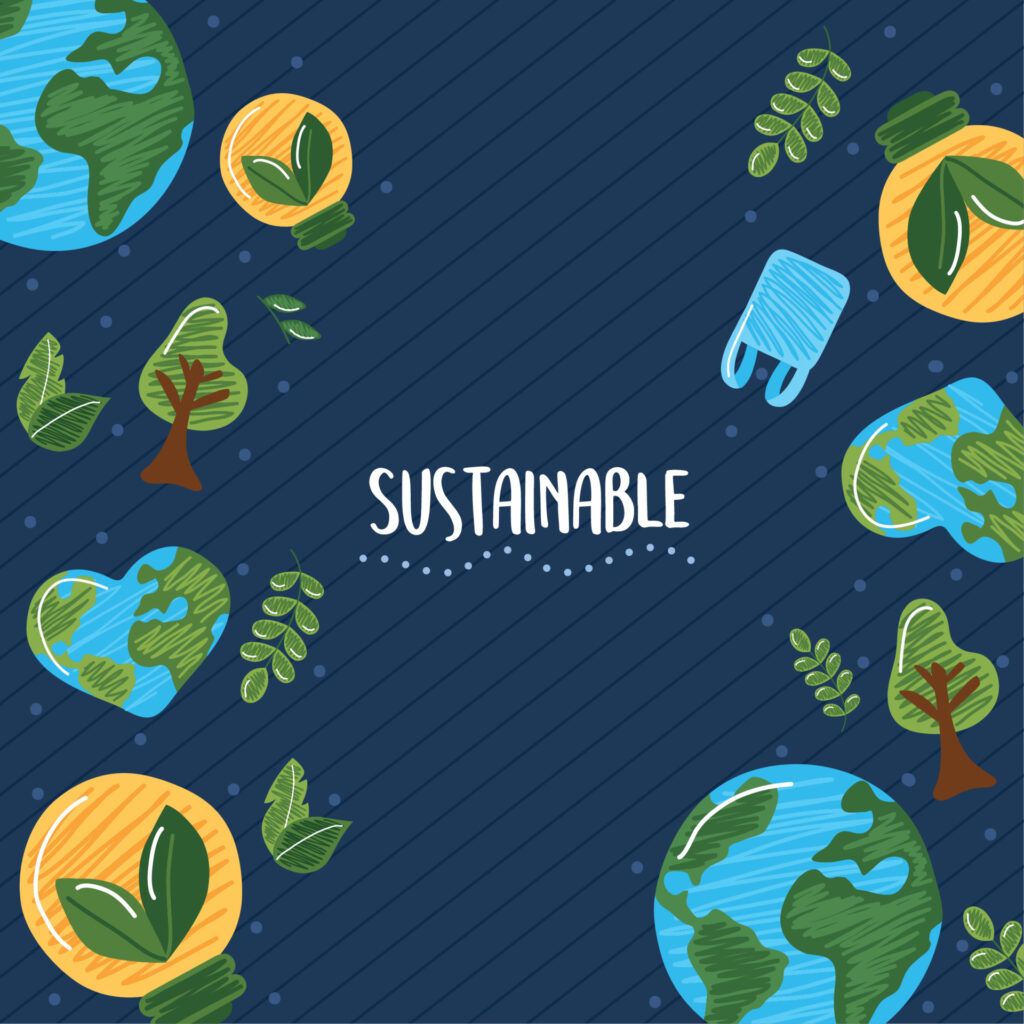
Some notable instances of personal greenwashing occur when someone proudly claims to live a sustainable lifestyle but privately indulges in a lot of junk food or drives a large SUV when a more eco-friendly option is affordable. I understand that breaking certain eating habits and challenging our attachment to vehicles can be uncomfortable for many Americans.
Simply Sustainable Lifestyle is here to encourage you to reflect on your choices, not to scold or wag a finger. Let’s all take a moment to consider our sustainability in our own unique ways, taking into account our income and the feasible changes we can make. It’s important not to be too hard on ourselves; this approach isn’t psychologically sustainable either. Instead, let’s be gentle, acknowledge our progress, and focus on that rather than dwelling on perceived failures.
Recognizing Greenwashing Tactics – The Marketing Mirage
Environmental Buzzwords: Certain terms like ‘eco-friendly,’ ‘sustainable,’ or ‘natural’ can influence consumer choices without substantial evidence backing the claims. Be aware, look a little deeper than the front of a package. Do your research and subscribe to blogs like Simply Sustainable Lifestyle and others that help you know the companies that commonly cheat you with “green” terms, opt for another choice if at all possible. Consumers have power. When we collectively begin to make different choices, these companies notice and will change their actions. They will make the business decision that serves their bottom line. We can be the force to encourage their behavior toward legitimate sustainability that serves our well-being. For more info on “geen” words click here.

False Representation: Instances where companies misleadingly portray their products as more sustainable than reality, exploiting consumers’ trust. Some of this is intuitive, things like a “natural” cereal with loads of sugar. Or toilet paper brands with catchy slogans that imply they are allies to nature but use bleach in their process and the packages are wrapped in plastic.
Industries Prone to Greenwashing: Sectors such as textiles, cleaning products, and fast fashion commonly engage in misleading eco-friendly marketing. Be very careful here. Take extra time when it is time to purchase these items. Make some global choices, buy clothing second-hand or only from companies you have vetted for sustainability. The same with cleaning products, research ahead of time and when you are out of a particular cleaning product know where and what you will purchase.
You can also use homemade cleaning products with vinegar, hydrogen peroxide, baking soda, and other more natural ingredients. Here is a link to an article, and a book to help you decide if a homemade product can do the job for you.
Unveiling the Deception

Signs of Greenwashing: Signs indicating a product is misleadingly marketed as eco-friendly, such as vague claims or lack of evidence to support green assertions. Here is a list of things to look for when sleuthing for products that support your sustainable lifestyle.
- Vague language: Words or phrases lacking clarity or precise meaning (e.g., “eco-friendly”).
- Misleading visuals: Pictures suggesting environmental benefits without substantial evidence (e.g., flowers sprouting from car exhaust pipes).
- Irrelevant assertions: Highlighting a minor green aspect amidst predominantly non-green attributes.
- Exaggerated superiority: Claiming to be greener than others, even if the comparison involves largely unsustainable practices.
- Deceptive claims: Marketing items like “eco-friendly” cigarettes that don’t actually make the product safe.
- Technical jargon: Using scientific terms or information that’s difficult for the general public to understand or verify.
- Fictitious endorsements: Creating labels that appear as third-party approvals without any substantiated proof or validation.
- False information: Presenting entirely fabricated claims or data without any basis in reality.
- Detecting Real Sustainability: Utilizing credible certifications and labels as a guide to discern genuinely sustainable products amid greenwashed offerings.

How to Navigate Personal Greenwashing
Empowering Consumer Choices
Certifications and Labels: Understanding the significance of credible certifications (like Energy Star, Fair Trade, USDA Organic, etc.) in authenticating eco-friendly claims.
Being Proactive: Adopting a vigilant approach by conducting thorough research beyond marketing claims before making purchases. Impulse purchases are dangerous. It is best to be thoughtful about your buying choices. The “I want is now” scenario is something we should put in our rearview mirror as something we have grown out of.
Consumer Empowerment: Leveraging consumer power by supporting genuinely eco-conscious brands and holding deceptive ones accountable. Use your consumer power and where appropriate write a letter to the company that is not being faithful to a stated mission of sustainability.
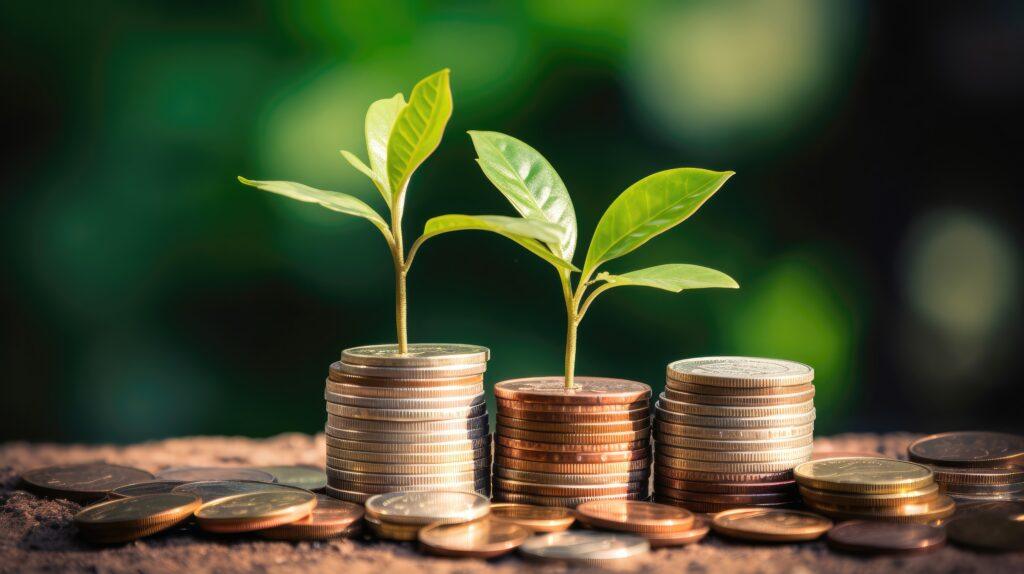
Real-life Scenarios: Unveiling Greenwashing in Products and Companies
Examining Case Studies
Unveiling the Curtain: Real-world examples revealing companies caught in greenwashing practices and the impact on consumer trust and the environment. Here is a link to the thumbs-down report recently published in Simply Sustainable Lifestyle. A good place to start.
Learning from Mistakes: If you realize that you have been inconsistent with your own stated sustainability goals, don’t let guilt turn you away from positive change. Make the change and learn from the experience. Share with others. Sometimes other people will perceive a sustainability-minded person as seeming like they feel better in some way than others. Admitting our errors and that we are still learning may help others make changes for themselves. We must be humble in the pursuit of saving the planet. We are in this together, there is no Planet B.
Impactful Actions: Understanding the pivotal role of informed consumers in driving authentic sustainability and pushing for transparent practices. We the consumer are a powerful source for change. Think about cigarettes for instance, and how quickly we went from smelling smoke everywhere to not having it in most public places. That is consumer power at work.
Conclusion: Paving the Way Forward – Shaping a Greener Future
It is our collective responsibility to create a greener future for the planet. The power of informed consumer choices is in our hands. We must hold companies accountable for their claims. When we are informed, we can make choices to use our buying power. Simply Sustainable Lifestyle will continue to help inform you about companies and products that fail the greenwashing test. We will also promote products that are true to their sustainability missions. Check out our thumbs-up and thumbs-down articles we update and add articles regularly to help you simplify your research.

Action Steps: In the world of sustainability, being an informed and conscientious consumer is paramount. By staying vigilant against greenwashing tactics and arming ourselves with knowledge, we can navigate through the maze of eco-labels and marketing claims. It’s about more than just buying products; it’s a mindset. Embracing genuine sustainability involves asking questions, seeking transparency, and making informed choices that resonate with our values.
Let’s continue to champion authenticity, support ethical practices, and drive meaningful change with every purchase. Together, our actions not only shield us from personal greenwashing but also steer the course toward a more genuinely sustainable future. Click here for a list of actions you can take.
Keep an eye out for new articles from Simply Sustainable Lifestyle that will provide you with a list of non-profit and government resources to help you research products. We will also provide an article very soon about the symbols you see on products and what they mean to help you be an informed consumer.
We use Affiliate Links to sustain Simply Sustainable Lifestyle’s writing and research. We curate goods and services that enrich the simple and sustainable lifestyle experience. As an Amazon Associate I may earn from qualified purchases
Below you will find companies we stand behind. If you click the link it will open in a new window so you can keep reading the blog if you desire. Enjoy shopping sustainably.

We’ve tried their product, and it not only cleans our clothes effectively but also feels great to support a company making a positive impact on our planet. Check it out here.

With EcoRoots you know that:
- All the products are ethically sourced
- 1% For the Planet
- All products and shipping are plastic-free and they only use recyclable materials for packaging.
A one-stop brand for zero-waste alternatives to everyday products.
From home and cleaning to beauty and skincare products,
Sustainable and zero-waste products for a better you and a better planet!
We’d love to hear from you about this article or our website. Please make comments below and take a minute to sign up to be on our email list. We will periodically send you notifications of new blogs you won’t want to miss.
Simply Sustainable Lifestyle
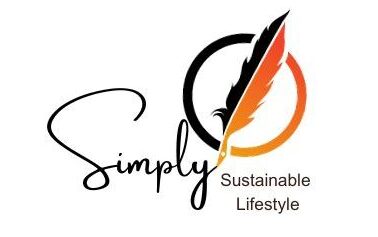
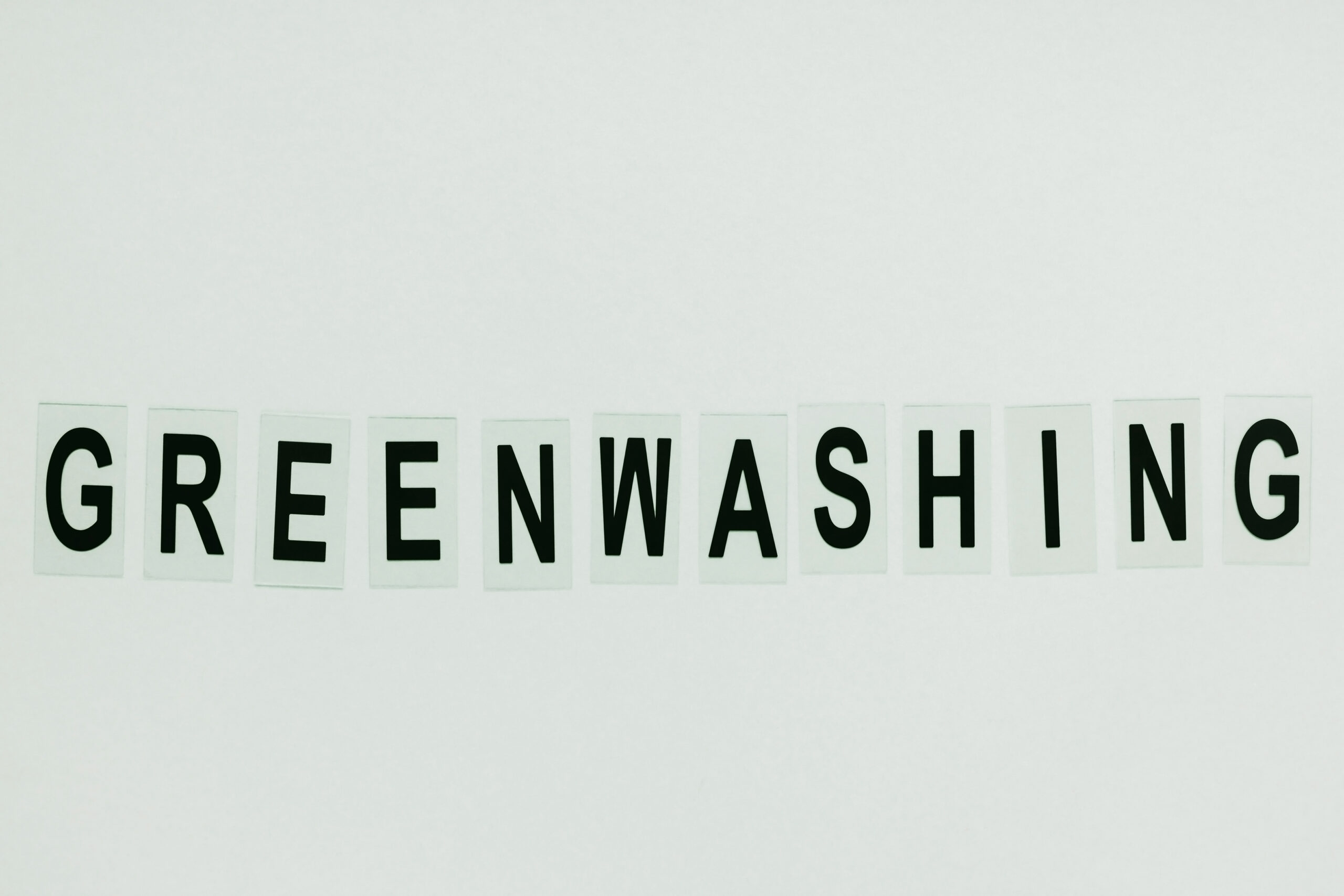
Very important info. Thank you very much!
Thank you Ola,
Glad you like the info. Good luck in your own personal sustainability lifestyle.
Linda
Always great to put a name with a phenomenon, like “greenwashing”. I’ve definitely heard of/seen companies doing this (making their products seem more natural, eco-friendly, and sustainable than they actually are), but never knew there was a term for it.
It’s particularly interesting you pointed out *personal* greenwashing though. Wow, yea I guess I’m kind of guilty too sometimes. Especially throwing something in the recycle bin that isn’t really recyclable (like a lot of plastic).
Thanks for your comments Ben,
Yes, we are all learning and growing. As we at Simply Sustainable Lifestyle do more and more research we find areas we did not know or have ignored as well. But awareness is the first step. That is what we strive for. It is our goal to bring a large amount of information about living sustainably to our readers in a simplified and understandable way so it will be easier to make the changes that will create a more sustainable way of living for all of us.
Creating a greener future is indeed a collective responsibility. Informed consumer choices play a crucial role, holding companies accountable for their sustainability claims.
How does Simply Sustainable Lifestyle assess and determine if a company or product passes the greenwashing test?
Can you provide examples of products that have received a thumbs-up for their sustainability missions?
How frequently does the platform update its articles to ensure consumers have the latest information on eco-friendly choices?
Lastly, in what ways does Simply Sustainable Lifestyle aim to simplify research for individuals looking to make environmentally conscious decisions? Thank you so much for this valuable information.
Thanks so much, Bushra for reviewing my blog post. To answer your questions:
How does Simply Sustainable Lifestyle assess and determine if a company or product passes the greenwashing test?
We are doing an extreme amount of research with each article we write. There is so much information that we must verify when the research was published, by whom, and what affiliations the research has and then complete the research to simply as much as we can provide our readers with easy-to-understand information.
Can you provide examples of products that have received a thumbs-up for their sustainability missions?
In our Thumbs up category, we now have 4 listed. We are constantly looking for more to add to this list. It is good if our readers check now and then to see if Thumbs-up and Thumbs-down items have been added. Thumbs-up items right now are Wealthy Affiliate, Pact Apparel, Reusable Silicon Storage Bags, Earth Breeze, and a book review called Climate Change Simplified.
How frequently does the platform update its articles to ensure consumers have the latest information on eco-friendly choices?
We scan articles every week to be sure they are still current and factual. We also depend on our readers and social media comments to check our work to be sure we are a trusted source of information. When people have questions we with either have the answer or will do the research to help them get the answer.
Lastly, in what ways does Simply Sustainable Lifestyle aim to simplify research for individuals looking to make environmentally conscious decisions?
Simply Sustainable Lifestyle strives to be a go-to source of high-quality trusted information for those wanting to live a sustainable lifestyle. We have designed our website to have navigation that will help people find the information they are looking for. This is a work in progress. By adding categories and using the top menu and drop-downs to look at the offerings, users can quickly find the information in the area they are looking for.
Hi Linda,
very detailed information here on greenwashing. I’ve found it very useful. Thank you so much for taking the time to put these together for our benefit. Very informative website.
Hi Kessy,
Thanks for reading the blog post. Hope the info was helpful to your sustainability efforts.
Linda